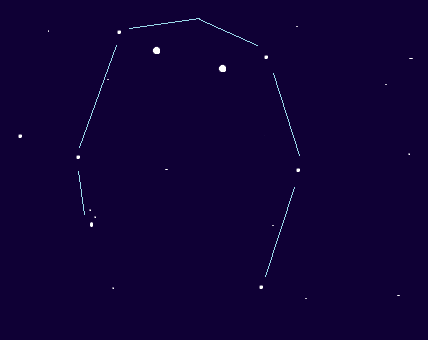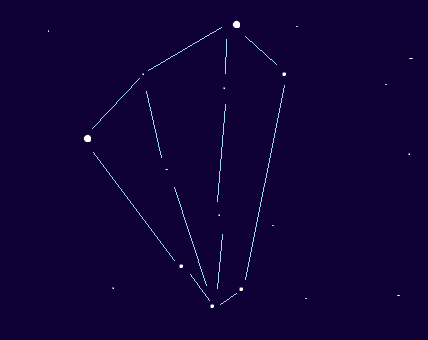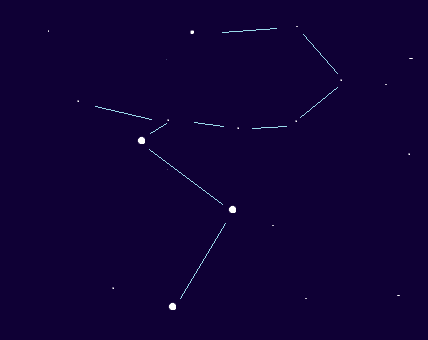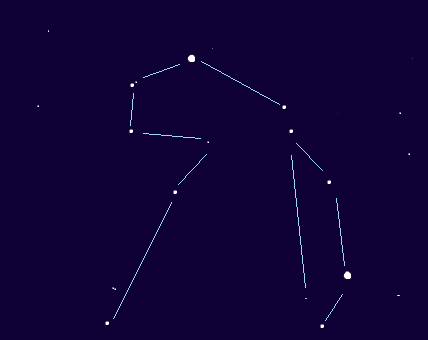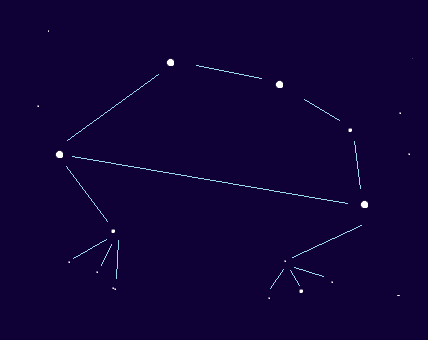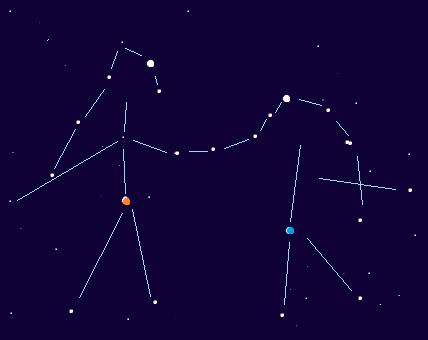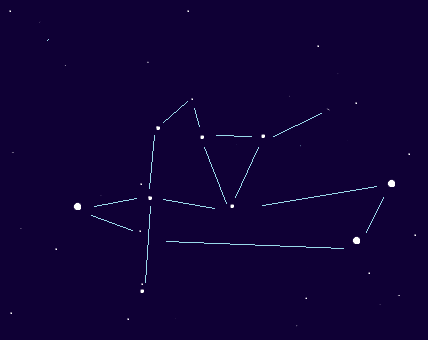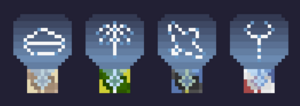Skrell Faith
| Skrell Lore Pages | ||
|---|---|---|
| Skrell | Skrell Biology · Skrell Relationships · Notable Skrell | |
| Planets, Systems, Settlements | Qerrbalak · Qerr'Malic · Aliose · Aweiji · Tattuqig · Xrim · Diulszi · Skrell Abroad · Notable Skrell Systems and Locations · Generation Fleets · The Prescient Republic of the Qar | |
| Organizations, Factions, Politics | Nralakk Federation · Skrell Politics · Skrell Enforcement · Federation Crime and Resistance · C'thur in the Federation · Dionae in the Federation | |
| Culture, Society, History | Skrell Culture · Skrell Cinema and Idols · Skrell Education · Skrell Technology · Skrell Cuisine · Skrell History · Skrell Beliefs · Skrell Mythology | |
Skrell Faith
Skrell faith has changed over the millenia, but the overlapping theme in all Skrell religions is the reverence of the stars. While other species eventually developed their faiths further the Skrell maintained this deification of stellar bodies since their inception, influencing their views on space and scientific advancement even today.
Qeblak
As Qeblak relies on astronomy and other sciences to practice the faith, it is seen as the more academic Skrellian religion. Those who practice Qeblak are more likely to emphasise the importance of knowledge and learning when compared to Weishiin Skrell. Qeblak is also seen as the religion most favoured by the Nralakk Federation by its critics; its centralised hierarchy and established orthodox doctrine allow greater control, making it an effective tool to ensure its followers are loyal to the Federation. The Nralakk Federation officially makes no distinction between Qeblak and Weishii, treating both as equally sanctioned religions within Federation space, however some discrimination has been unofficially noted, with the Federation favoring Qeblak followers over Weishii followers in reality.
History
The roots of Qeblak were first established in its predecessor religion, Qe’qlak, which was a religion that worshipped and deified the stars as gods. However, as Skrell society progressed, the Great Schism occurred around 5500 BCE, which occurred after an unknown priest began to preach a more scientific interpretation of Qe'qlak based on the practice of Zareq’Eaq, or Cosmic Mathematics, a principle combining astronomy, mathematics, and astrological theory to plot and track changes in stellar bodies and define meaning from them. The introduction of science into religion caused a massive rift in Skrell society at the time as understanding of the nature of the stars became more understood, and many heresies or offshoots of Qe'qlak began to take root. Qeblak, because of its favour with the more educated and higher-status Skrell that it appealed to, was promoted heavily to tribal leaders and the masses that these Skrell held influence over. This allowed it to cement itself firmly during the Schism and would soon make it the dominant faith on Qerrbalak, overtaking Qe'qlak and any other minor sect that sprouted during this time, sequestering them to small isolated tribes and conservative Skrell who were resistant to change. Qeblak went under massive reform with the formation of the First Nralakk Federation, primarily in the form of a rigid, hierarchal clergy that made it resistant to theological drift as the Skrell expanded out towards the stars. Its guiding doctrines allowed Qeblak to withstand the millennia; where there was a massive cultural, scientific, and societal change, Qeblak relatively stayed the same as it was when it was first formed, only seeing reform when it best suited the Federation and its aim of keeping the Skrell united. This said, Qeblak's ability to unite the Skrell has waned post-Glorsh. Its well-established history and favour by the Federation Government has allowed it to stay popular well into the 25th century, but the popularity of Weishii now threatens its dominance as the primary Skrell faith.
Practices
Followers of Qeblak believe that calculations through a process known as Zareq’Eaq, or Cosmic Mathematics, it is possible to predict terrestrial events from celestial observations. These events include those that can be observed through regular astronomy while including more astrological and religious ideas. An observation of a moon's orbit, along with the time of year, its current phase, and other factors can be combined to create a prediction on how these events will impact local events from mood changes to agricultural yields and natural disasters. Zareq’Eaq involves an extremely confusing practice of calculations of star positions and constellations that often takes decades to master, and most non-clergy find this impossible to do, instead relying on Starkeepers. Skrell proficient at Zareq’Eaq will often find themselves working in the field of bluespace navigation, due to their mathematical prowess. It is not unusual for Qeblak clergy to have served a stint on a Federation vessel as a bluespace navigator as a result. Interestingly, the C’thur hive’s Vaurca have shown to be extremely adept at this practice, to the point where they are often sought out as Starkeeper assistants due to their proficiency in Zareq’Eaq. Their actual belief in the faith is not considered a barrier by many in the Qeblak clergy, with many Starkeepers and Starchanters appreciating the ease in workload.
Members of the Qeblak faith come together on a biweekly basis at their local Observatory Dome, a building that acts as both a church and a place of astronomical study. The Nralakk Federation does its best to ensure that at least one Observatory Dome is within a reasonable distance per thousand Qeblak followers, and that everyone has reasonable access to its facilities. Starkeepers are the hosts of these Domes, more senior members of the Qeblak faith who are tasked with the maintenance of the building, while also being in charge of organising events where members of the community can practice the faith. The more common events involve lectures on a given galactic entity such as stars, planets, or nebulae, which are showcased using holographic projectors to allow attendees to see and experience what is being covered. Non-Skrell who attend these events describe it as an ethereal experience.
Outside of the Federation, Observatory Domes can vary in terms of quality and ease of access. In Tau Ceti in particular, the Starlight Zone in Mendell City is the only location with established observatory domes, with most being located in the Lekan District. These domes are not as spectacular as those found in the Federation, with only a handful having access to the holographic projection equipment necessary to provide a similar experience as Domes in the Federation. There are also a few Observatory Domes located within Severson City, and are more unique in that they are built upon mobile barges that go out to sea for their biweekly events. These barges are quite small, however, meaning that many Qeblak followers within Severson are forced to cross into the Lekan District to practice their faith, much to their annoyance.
Leadership
Qeblak is governed by only particular Skrell, those demonstrating extraordinary psionic prowess. It is believed that only the most powerful of psionics are capable of accurately gleaning information from astronomical objects, and translating the information received from them. The clergy, known as the "Qyu-Nyala", is composed of different ranks depicting how far a Skrell is on their journey as religious leaders.
OOC Note: The highest rank a character can be playable as is a Starkeeper.
Qe'Puu - Starpages
The Qe'Puu are the youngest, usually around the ages of 40 - 50 years old. They are typically Skrell with high psionic potential that have chosen to devote their lives to Qeblak, and will undergo apprenticeships to observe and learn from those that have come before them. They will remain as Qe'Pluu until they successfully pass a series of tests - both in knowledge and psionics. They usually tasked with menial labour, such as organizing a higher-ranking member's astrological charts or cleaning the places of religious worship - a massive temple that has a glass ceiling to enable transparent viewing of the sky above known as "The Observatory Domes".
Qe'Naho - Starkeepers
The Qe'Naho are above the Qe'Puu, and are described as the 'protectors of Qeblak'. The Qe'Naho are seen as the next generation of Skrell that will lead the religion and as such are expected to ensure the protection of the faith through rigorous studying of the doctrines, and uphold it at all times. Qe'Naho can only ascend the ranks of Qeblak if a higher-ranking member retires, which shifts the hierarchal system that guides the faith. Starkeepers act as counsellors, advisors and community spiritual leaders.
Qe'Bqak - Starchanters
The Qe'Bqak are the highest-ranking members of Qeblak, and are considered masterful psionic wielders. They study astronomical objects, transcribing them into Lu-Qsi (Abyss Journals). Skrell that receive this position are expected to retire once they believe they have completed their work, with the culture of the Skrell usually resulting in them retaining the position until their death. Qe'Bqak are the only members of the clergy allowed to give advice to the Grand Councillor.
Qe'Kasho - Starseeker
The Starseeker is a role of authority within the Qeblak faith, with the main responsibility of managing and organising the clergy. It has no authority outside of matters related to Qeblak, and while superior to Starchanters within the faiths internal structure, the Starseeker is unable to provide advice to the Grand Council in any official capacity. Becoming a Starseeker can only be attained through assignment by Starchanters through a divination ceremony, performed soon after the death of the last Starseeker. The ceremony itself requires five of the most senior Starchanters to come together at the Qeblak'i archive, who will discern who will be the next Starseeker based on their findings.
There are no official requirements to being a Starseeker other than being a fully grown adult (by Skrellian standards), and to be a member of the Qeblak faith, but all recorded Starseekers have so far been Skrell of high psionic aptitude and are typically primary numericals within Federation society.
Holy Prayers of Qeblak
Miasmic Cluster (Gaqq-qu'ya)
This prayer is used to ask for forgiveness, especially so when a Qeblak adherent violates one of the main doctrines of Qeblak. In the Federation, this is a popular method of attempting to salvage a low Social Compatability Index rating - by pleading forgiveness from the Stars in hopes that the Federation takes note and increases their index rating.
From the path one fell, where their duty lay neglected, there is only forgiveness to ask, of the cosmos that has yet to be traversed, allow one time to re-ascertain their goals, and return to the path aligned for them.
Beginning of the Protostar (Wetl'qu-Qih)
This prayer is used to signify “new beginnings.” This prayer is commonly used after a Skrellian egg hatches, after a coming-of-age ceremony, and after a Federation citizen undergoes the process of rehabilitation.
The humble beginnings of all, the start of a process anew, all that one asks is for the stars to align, and grant aid in the future to come, so that one can travel the path created, for it is only through obedience, can one strive for success.
Devourer of the Cosmos (Eqqa-Luyal)
This prayer is used exclusively in funerals and death rites, to ensure that the soul of the given dead person will be properly guided by the stars.
Hallowed cosmos, custodian of life and death, the price has been paid, align the stars and guide, the souls of stardust, that have since left our world.
Star-Bright (Qu-qu'qu)
This prayer asks for the protection of the stars, commonly used before entering a risky situation, examples including a hull breach, a gunfight, and before piloting a shuttle.
Shining bright amongst, the most blessed of stars, it is the cosmos one calls, to give it praise and admiration, its beauty ever-unfolding, its rage known, one can all but ask, for protection.
Marriage & Death
Marriage is considerably different for Skrell, as their relationships are typically not as monogamous as the other species found within the Orion Spur. Ancient followers of Qeblak created a ceremony for the joining of various Skrell, eventually calling it the "Pairing of the Stars" or "Quy-aqa", which has survived for thousands of years and evolved to what it is today. The ceremony is considered incredibly intimate, and a sign that the Skrell within the newly forming Quya respect the foundations of the union. The actual planning of the ceremony can take years, with minute details considered highly important to the result of the ceremony. Most will take place within the Observatory Domes, hosted by the same number of Starkeepers as there are Skrell willing to form a union.
The actual ceremony will commence just after sunrise, and is expected to occur throughout the whole day. Skrell from the Quya will select a Starkeeper, who will eventually be told about the respective Skrell's wishes and desires in regards to the formation of the Quya. After the process has concluded the various Skrell will be escorted to a circular altar, where they will each stand opposite of another and join hands. The Starkeepers will then circle around the union, each psionically expressing the knowledge given to them by those within the forming Quya. After this is done, the Skrell will psionically bond through the use of a process known as "mind-melding". This process is the final step in the ceremony, and is meant to symbolize the attachment to each Skrell within the Quya. Should they wish, the Quya will then be registered within the Nralakk Federation.
Death is not considered the end by the Skrell; merely a temporary transition between what is here, and what is within the cosmos. Qeblak describes death as being an invitation to join the cosmos, whether as the smallest comet or the largest quasar, all Skrell are said to join those who have already departed. The most common method for post-mortem instructions is burial, so that the body can be reabsorbed back into the environment it stemmed from.
Doctrines
The Doctrines of Qeblak, or known as the Qrikiqi, is a set of virtues which constitute the major practices of Qeblak. They are:
- Waaq Qrikiqi: Studious (Nral'Malic: Wa'Pii)
Studying and the gaining of knowledge is a cornerstone of both Skrell culture and the Qeblak faith. In context, this virtue is the studying of the stars and constellations, and divining meaning from the viewers interpretations.
- Laqiq Qrikiqi: Obedience (Nral'Malic: Laqiq)
The virtue of obedience can be interpreted in many ways, but is normally recognised by practitioners as viewing and accepting the teachings of Starkeepers and Starchanters. Another interpretation commonly held is obeying the will of the universe.
- Qowii Qrikiqi: Tolerance (Nral'Malic: qo'Wiq)
Like obedience, tolerance can be interpreted in multiple ways. Most accept that its meant in a more general form, and that followers should show tolerance for what the constellations say, and how sometimes you may not receive the interpretation you wanted. Alternatively, it can also be seen as tolerance for those not of the Qeblak faith as well as non-Skrell.
- Vri'Wii Qrikiqi: Diligence (Nral'Malic: Vqiwii)
Diligence is one of the more straightforward doctrines of the faith. The proper study of the constellations must be made in order to receive the most accurate interpretation.
- Nlamo Qrikiqi: Patience (Nral'Malic: Nlaq'Wo)
Patience, like above, is a straightforward doctrine. Patience, diligence, and study are all needed in order to properly read the constellations, but patience is taught in particular as rushing to conclusions ultimately leads to false readings.
Weishii
A relatively "newer" belief within the Nralakk Federation; Weishii is a schism of Qeblak that flourished during the post-Glorsh reconstruction of the Skrell species.
History
Weishii first took its roots from a prominent Lyukal leader, Qare’Zaq Marayar, who was one of the fighters who took part in the Tri-Qyu assault. Marayar became disillusioned after Glorsh's rule, unable to fully come to terms with the consequences of the tyrant's reign and becoming heavily religious in the years after as a result. Unsatisfied with Qeblak and concluding that it could not fully answer their questions on life, especially after Glorsh-Omega's treatment of the Skrell, Marayar began exploring other means of communing with the stars. Marayar claimed that through spirituality only the true meaning of the stars can be ascertained. Many Skrell, traumatized and battered from the chaos that Glorsh wrought upon them, took solace in this belief. Despite the Federation being fractured, Weishii began spreading steadily, originating in the Traverse and being spread through the mass migration of Skrell followers into both the core and Traverse systems as part of the Federation's reconstruction efforts. Around 2163, the Ron’tor’aq was published, a series of intricate teachings on the Weishii faith published by Marayar themselves, and this book quickly became the cornerstone of Weishii beliefs. By the time the Tresja Agreement took place and the Federation was officially reunified, there was a substantial population of Weishii followers, and the religion took hold, particularly in the Traverse where many planets suffered heavy devastation as a result of the post-Glorsh cataclysm that occurred. However, from the start, there was always conflict with Qeblak. Debates were commonplace, , with one of the most notable ones being the Haq’Zaq debate, in 2200, held on Mount Haq’Zaq on Qerrbalak. This debate was held over the course of a week and concluded with the Federation officially recognizing Weishii as a distinct religion from Qeblak despite pushback from the clergy and more traditionalist devotees of Qeblak. Attitudes towards Weishii further declined as the Federation’s elite began espousing the importance of unity and the Nlom Relay network was restored. While not explicitly prohibiting the religion, many idols began to criticize the unorganized and spiritual fashion of Weishii compared to the more stringently organized and well-established Qeblak. Towards the present day, many members of alternative religions such as Kir’gul and Suur’ka have flocked to Weishii due to its decentralized nature and looser oversight from the Federation. The disorganized nature of the Weishii has resisted Federation attempts to implement a formal hierarchal structure, with Weishii sects often choosing religious clergy through democracy instead of strict criteria. Weishii sects are especially prominent as one goes further out into the Traverse, with Skrell living there finding themselves less inclined to follow Federation ideals due to the conditions they face and a generally weaker presence of the Nlom. Following first contact, there has been a noticeable migration of Weishii followers out of the Federation, claiming that they felt persecuted by the rest of Federation society. While Weishii is still widespread, their followers are rarely in the high castes of Skrell society.
Beliefs
Weishii follows a decentralized belief system, with certain religious beliefs and rituals differing widely throughout each sanctuary. However, the main belief of Weishii is the ability to gain a more spiritual understanding of the universe through both private and communal meditation, which involves intense emotional experiences shared with other Skrell, contrasting with the rigid calculations and mathematics of Qeblak. These spiritual experiences are often assisted through the religious use of the plant Wulumunusha. Weishii followers believe that through consistent meditation, believers can become highly attuned with a form of Srom manipulation known as the Qu’Srom, or the Star Dream, through which believers claim to have a direct connection with the stars. Wulumunsha is often cited in the Ron’tor’aq as a tried and true path to achieve a psionic connection with the stars, with a common practice involving observing constellations or performing a qwei’paqui drawing, imbibing a wulumunsha tea, and entering the Srom.
The Qu’Srom is often done in conjunction with a large gathering of Skrell at Weishii sanctuaries, as it allows for high-scale dream modification that enhances the divination process with the stars. A more personal version of this ritual can be done either alone or with a small group, but this is more common when a believer finds themselves without a nearby Weishii Sanctuary or while traveling. Skrell who perform Qu’Srom rituals regularly has shown a higher level of activity in their Zona Bovinae during Srom. They have shown proficient levels of skill within the Dream, able to do feats of dream manipulation uncommon to most Skrell. This phenomenon is especially pronounced in Weishii masters and journeymen. Believers who claim to have achieved this attunement describe it as “having their brain divinely imprinted with an intense understanding of the universe and life itself.” Qeblak believers vehemently deny this concept, the phenomenon being considered just a matter of practice in the Srom and having nothing to do with divine blessing.
While Weishii and Qeblak follow the same basic belief of finding divinity in the stars through observing constellations, their beliefs often come into conflict. While Qeblak might encourage heavy education, both recognized academic education such as astronomy and education more related to religious concepts, to gain true knowledge of the cosmos, along with rigid calculations and scientific methods, Weishii believes the same may be achieved by guided meditation and the use of psychedelics, along with strong emotional experiences shared with other Skrell. However, compared to the average Skrell, Weishii followers consume wulumunsha at a higher rate and regularly use it for Qwei’Paqui readings, which is often seen by other Skrell as a form of overindulgence, especially by those who have a high Social Compatability Index rating. This has led to a popular stereotype of devout Weishii believers being known as lazy layabouts compared to their Qeblak counterparts, and overall unideal citizens. Evidence of this can be seen by critical observers of the Social Compatability Index, who note that there are very few Weishii followers who are upper Secondaries or higher.
Weishii relies on natural groves, jetties, grottos, thickets, coves, and other secluded areas that provide suitable sanctuaries to practice the faith. This reliance on nature has resulted in it playing an important role in the Weishiin faith; followers are more likely to have an appreciation for nature, while the more ardent followers will practice vegetarianism or veganism. Weishii as a whole does not put as much emphasis on academia when compared to those who follow Qeblak, although they are still subjected to the same cultural expectations of the Nralakk Federation. This has led to a trend where many Weishii followers abstain from Depth College, claiming that the intense schooling is disruptive to their beliefs and spirituality, and hinders their path to reaching full divinity from the stars. Many Weishii followers will stop their education after their first or second degree, with those holding more than two degrees typically being converts or followers who require three degrees for one reason or another.
Treatment within the Federation
Weishii has long been regarded by many Skrell to be a religion that breeds laziness and goes against the academic culture that Skrell is known for, a belief that becomes even more prominent when looking at high-scoring Skrell within the Social Compatability Index. The Nralakk Federation officially makes no distinction between Qeblak and Weishii, treating both as equally sanctioned religions within Federation space. However, in practice, Qeblak is the religion most favored by the Federation, and the Federation prefers this division between the two faiths. Weishii members often struggle to achieve upward mobility in the Social Compatability Index compared to their Qeblak peers, with the Federation citing that these citizens "simply do not uphold the same level of commitment to the values core to the Nralakk Federation” when asked for reasoning for their stagnant Index rating. A majority of Primary Numericals are devout Qeblak followers and often look down on Weishii, while Primary Numericals who do follow Weishii tend to avoid bringing attention to that fact to prevent any repercussions. Weishii and Qeblak followers often have conflicts abroad due to the difference in beliefs and popular stereotyping of Weishii followers as unproductive. While these conflicts rarely escalate to violence, the division between the two religions has only been widening throughout modern Skrell history. Many Weishii followers envy the privilege that Qeblak followers often have towards their Index rating and general treatment. Popular stereotypes amongst Qeblak followers include Weishii followers holding anti-Federation beliefs, having low Index ratings, hailing from the Traverse, and in rare cases being subversive or members of a criminal organization.
Leadership
Weishii's hierarchy is based on age stratification; where the eldest, in terms of being a believer, are usually those that oversee the faith. The "clergy" is split into three categories, each being a distinct telling of how far a believer has progressed within Weishii. The entirety of the "clergy" is known as the "Weishiiq". It is a very decentralized hierarchy, with the eldest of the Weishiiq typically left to make their own minor choices in regards to a sanctuary and how to teach. OOC Note: The highest rank a character can be playable as is Journeyman.
Wei'Qii - Apprentice
An apprentice is a young believer, who either has yet to learn about the faith or is in the beginning stages of their studies in regards to the faith. They are frequently assigned to journeymen to be mentored in regards to Weishii, mostly associated with the Ron'tor'Aq and the brewing of wulumunusha extract within various liquids - mostly Dyn tea. Apprentices are usually Skrell just out of Reefgarden schooling who have chosen to dedicate a considerable amount of time to memorizing the Ron’tor’Aq and training within the Srom. While Weishii beliefs and structure are variable, apprentices take an average of thirty to forty years before they graduate to the Journeyman stage.
Wei'Rii - Journeyman
A journeyman is an older believer within the Weishii faith and has managed to successfully provide evidence of their teachings to a Master. They are considered to be the mentors of Weishii and are obliged to tutor the fledgling apprentices. They are typically well-versed in the teachings of the Ron'tor'Aq and are expected to obey the doctrines set forth by the holy text. Journeyman are the Weishii Clergy most likely to be seen abroad, as many sects expect an aspiring master to create a smaller-scale form of a sanctuary, usually in smaller towns or communities, such as space installations or rural communities, and to hone their skills both in and out of the Srom in preparation for the intensive trial of Srom’Paq. Journeyman have a more pronounced ability to manipulate the Srom compared to the average Skrell but have not risen to the strength of a true master yet.
Wei'Vii - Master
The masters of Weishiiq have essentially passed through the chain from the lowly beginnings of an apprentice all through to the final stages of becoming a master; producing their own text that will be evaluated by the eldest of masters through the process of Kon'ra'Qii. Masters are also obliged to begin their own sanctuaries and foster a community in which believers can thrive and learn. Masters often lead Qu’Srom sessions and have a strong ability to manipulate dreams. Due to the decentralized nature of Weishii, there are no “true” criteria for becoming a master, although a popular way is the trial of Srom’Paq, or Dream Strength, which is a form of extremely psionically intensive dream manipulation challenges that gauge the aspiring master’s strength in leading and conducting Qu’Srom sessions, with examples being manipulating other Skrell within the dream and forcefully changing the entire dreamscape to their will. Masters are heavily monitored by the Sromkala while in the Federation, as the power they have to manipulate the Srom is almost unparalleled.
Holy Scriptures of Weishii
"For when there existed both light and darkness, there existed the cosmos. The benevolent energy, shared across the all-covering galaxy that would, be embued within the Skrell. It is only through, the understanding of oneself that one can, truly begin to ascend spiritually."
"Defiance goes against the teachings, even in its simplicity. One cannot be defiant, and obedient to the teachings. It is only through obedience, can one achieve excellence."
"Meditation within solace will yield, greater results than that of meditation, within the spur of a cacophony. Remaining, serene, even after the process of meditation, is a vital aspect for all students of the faith. Intrapersonal conflict must be dealt with, for the teachings to be useful."
Marriage & Death
The views on marriage for Weishiin are very liberal. It is considered not as a religious duty, and Weishii does not compel a person to be married. It does not force somebody to remain as a bachelor. It is not laid down anywhere that followers must produce children or regulate the number of children that they produce. It allows each individual the freedom to decide for themself all the issues pertaining to marriage.
Despite the faith not considering it a religious duty, there are various traditions and customs that are expected to be followed by those that wish to form a Quya. The ceremony is considered incredibly private, with most being only witnessed by the Wei'Vii initiating the Quya. The process is rather intimate, as the Skrell will all drink from a singular chalice spiked with wulumunusha extract - where they will then meditate and form a "Nlom'akk" or a "Psionic Link". This is meant to emphasize that the Skrell are no longer individuals, but a Quya.
Weishii have similar beliefs to that of Qeblak in regards to death; it is merely a transitioning stage. Once a Skrell has passed, a small ceremony will be held within a sanctuary, where both the Quya and Clergy will sing various hymns. This meant to draw the spirit of the Skrell out of its body, before the final process of the funeral rites - cremation. If the hymns had not drawn the spirit out, the cleansing burn will force it out.
Doctrines
The Doctrines of Weishii, or known as the Wei'Priqi, is a set of virtues which constitute the major practices of Weishii. They are:
- Agrok Wei'Kriqi: Determination (Nral'Malic: Agro'Qi)
Determination is a key component to the Weishii faith. Determination to one’s self and one’s future but also determination to the faith and the community as a whole. This doctrine is focused on bettering the individual and those around them.
- Ziroq Wei'Kriqi: Serenity (Nral'Malic: Zi'ro-Qii)
Serenity ties directly into the core tenets and practices of Weishii. This doctrine is often associated with the many meditations and tea ceremonies that are held by the Weishii faith. Followers of Weishii are often encouraged to be peaceful and serene in any situation.
- Qanhe Wei'Kriqi: Honesty (Nral'Malic: Kan'Chiq)
Being honest is the way of the Weishii faith. Lying is frowned upon due to the impacts it can have on the community and the individual alike. For a community to arise and respect each other, everyone must be honest and forthcoming with their feelings and grievances.
- Qlonii Wei'Kriqi: Wisdom (Nral'Malic: Wronoqi)
Wisdom is highly regarded within the Weishii faith and it is said to be the hardest doctrine to fully understand. What wisdom means is ultimately up to the individual; however, those who consider themselves wise may be shocked to hear that others may not view them the same. This leads wisdom up to the interpretation of the individual, but also the community.
- Wra'Qos Wei'Kriqi: Acceptance (Nral'Malic: Qonros)
Acceptance is fairly straightforward. Those with an open, and friendly, mind will be accepted into the faith with no issue as long as their intentions are pure. Weishii is also accepting of those willing to change and align with the core tenets. Being welcoming to those of all backgrounds is extremely important to the followers of Weishii and the community around them. Those who participate in deductive behaviors within the Nralakk Federation are said to be impure by the Weishii faith.
Shared Constellations
The constellations deemed important by both Qeblak and Weishii followers:
The Island
Meanings: Loneliness. Introspection. Earth. Rising above, or, in certain orientations, sinking beneath. Reality.
The Hatching Egg
Meanings: New beginnings. A fresh start. Youth. Life. Excitement. Ignorance. Foolishness. Joy.
The Star Chanter
Meanings: Wisdom. Spirituality. Connection with the stars. Connection to history. Aloofness. A rigid path. Air.
The Jiu’x’klua
Meanings: Art. Creation. Loss. Sadness. Longing. Communication. The imaginary.
The Stormcloud
Meanings: Conflict. Shock. Surprises. Tension. Endurance. Strength. Force. Fire.
The Gnarled Tree
Meanings: Age. Wisdom. Sickness. Frailty, or, in certain orientations, toughness. Rigidity. Tradition. Plantlife. Balance.
The Poet
Meanings: Communication. Progress. Science. Advancement. Longing. Art. Expression. Loneliness. Contentment. Dreams.
The Bloated Toad
Meanings: Greed. Arrogance. Wealth. Success. Smugness. Laziness. Accomplishment. Adulthood.
The Void
Meanings: Death. Endings. Mystery. The unknown. Fear. Danger. Creation.
The Qu’Poxii
Meanings: Love. Friendship. Company. Opposites. Teamwork. Happiness. The material. Safety. Progress. Support.
The Fisher
Meanings: Hard work. Stagnation. Embarrassment. Water. Patience. A long, but productive wait.
Qwei’Paqui - Astrological Tarot Cards
Before the Skrell were able to reach other planets the Qwei’Paqui (Stargazing Cards) were rarely used; they were ideal for times when there were no stars in the sky to be observed, but typically the tarot was ignored for more traditional stargazing events. Post-Space Age, however, the Skrell have found more utility in having tarot cards on hand. As the Skrell move further and further away from Nralakk, it becomes impossible to see the main constellations that have reverence in Qeblak or Wesihii, making the Qwei’Paqui important for those who wish to stargaze away from home.
While not typically used by Skrell living in Nralakk, the Qwei’Paqui sees use by most Skrell in the Federation, with local decks including both the main Qeblak and Weishii constellations along with any local constellations that have been approved by the Qeblak church. The tarot also sees use outside of the Federation, with most Skrell communities such as Mictlan and New Gibson having their own local decks - the only exception to this being Europa, due to the colony being deep underwater.
Usage and How to Perform Readings
Readings are generally done using only the main constellations (those shared by Qeblak and Weishii) and the user's own minor constellations; cards with minor constellations that are not part of the user's home constellations are usually withdrawn from the deck, but can be kept depending on the deck owner’s attitude towards the minor constellations. For those who live in areas with no observable constellations, such as the Skrell on Europa, the Qwei’Paqui completely replaces stargazing. In these cases, only the main constellations shared by both Qeblak and Weishii are used.
Qwei’Paqui cards can either be normal facing or reversed facing; normal facing is associated with positive attributes, while reverse facing is associated with negative attributes. For constellations that have more neutral attributes, the connotations rely on how the card is drawn; the attribute ‘social standing’ associated with New Gibson’s Iqi Star could be seen as a loss or gain in social standing depending on the card’s facing, for example.
Card reading can also be used by those who are travelling, with the first instances of it being used this way dated to the Skrell Age of Sail; in the modern-day, those serving on Qukala vessels, trading ships, or otherwise travelling for long periods of time will use the Qwei’Paqui as a quick way of divining their fortune when being able to find constellations may prove difficult, or if stargazing would be too much of a distraction from more immediate concerns.
While stargazing is seen as a communal affair, the Qwei’Paqui is seen as more personal since the individual draws their own cards. Sharing any divinations made is still common and tarot readings can be done as a group, but any interpretations that can be made are regarded as a personal matter that should not be assisted with. The only exception to this are the Qeblak and Weishii priests, who are seen as better educated in divination than your average Skrell, and are generally relied on by followers to offer insight in the event that they are unsure on how to interpret their observations.
There are two types of readings that are common throughout Skrell society: Daily Readings and Bi-weekly readings. Daily readings became popular during Qerrbalak’s Age of Sail period; the violent weather patterns of the planet made travel by sea a dangerous affair up until modern sailing and weather prediction were innovated, which made regular tarot card readings popular for the more superstitious Skrell. Daily readings are performed by shuffling the deck and taking four cards, where one card acts as the centre, and the other three cards take place left, right, and above it. The centre card represents the main focal point of the matter, while the other three cards will describe the events surrounding it. Daily readings are only used on their own, and during times when stargazing would either be impossible or dangerous while travelling.
Bi-weekly readings were the first method developed to use the Qwei’Paqui, being used in conjunction with stargazing events or on their own if the skies did not allow for stargazing with the naked eye. These readings tell a story by linking past, present, and future events together; Three cards are drawn after shuffling the deck, and from left to right are meant to represent an event that happened or will happen in the user’s past, present, and future. Any divination made using the bi-weekly reading is seen as separate from any readings made while stargazing if both are used at the same time, but they can be tangentially related.
Outside of these readings, some Skrell are known to come up with their own way of divination through the Qwei’Paqui. This is typically done by Weishii followers due to the less dogmatic nature of the religion, while Qeblak followers tend to stay to the readings that are approved by the church.
Examples of Qwei'Paqui cards
Syncretism of Skrellian Beliefs
Due to the structure of both Qeblak and Weishii being more inclusive than most religions, the Skrell faiths have gained a small following of non-Skrell, most notably Humanity. The studying of stars and constellations from Qeblak, and the spiritual focus in the Weishii faith both appeal to those who follow nontheistic religions, such as Buddhism. This has also worked inversely, with some Skrell co-opting parts of Buddhist teachings that they believe compliment their own faith.
Other than the religious aspects, Skrellian practices have found a small following in human circles, such as astrologists; Constellations and their interpretations are used similarly to how they would be used in the Skrell faiths, but without associating divinity to them or any other religious connotations. This has had mixed reactions from Skrell, with most opinions ranging from dismissiveness to annoyance.
Requirements for Employment With Megacorporations
To ensure that the role of Chaplain aboard Megacorporation facilities is carried out by qualifying personnel, the Nralakk Federation and Qeblak Starchanters have provided a list of requirements for those who wish to be employed as a priest. Potential applicants must:
- Hold the title of Starkeeper within the Qeblak faith.
- Be at least 120 years of age.
- Hold a degree in theological studies or a similar field, as well as a second degree related to astronomy.
- Have a minimum SCI of 6.7 for Federation citizens.
Due to the decentralised nature of Weishii, the Federation and notable Weishii followers have been unable to provide a clear list of requirements for Weishii priests. As such, the only requirement for an employed priest of the Weishii faith is that they are either currently a Journeyman or Master of the Weishii faith, and have received some form of formal education in theological studies.
Religious Holidays and Events
Coming of Age
Qeblak Ceremony
For Qeblak believers, this ceremony is more like a religious exam. The Skrell who is going through the ceremony will enter their local observatory with their Starkeeper. The Skrell must then recite the Wetl'qu-Qih, or 'Beginning of the Protostar'. Once this is done, they will have to go through a rigorous exam where their knowledge of the faith is tested, before finally being given a set of constellations to identify. After identifying the constellations they must state what each constellation means to them while their mind is being read by the Starkeeper. Once the ceremony is finished, the Starkeeper will divine a 'fortune' for the Skrell, giving them a glimpse of what their life will be like using the interpretations given earlier, as well as advice on how to ensure or alter this path. Afterwards, they are given a shoulder cape and greeted by their close friends and family as they celebrate.
Weishii Ceremony
For Weishii believers, the ceremony is a lot more relaxed, with an emphasis made on the person's spiritual readiness to become an adult, rather than testing. The ritual is hosted normally by a Wei'Vii, a Master of the faith, and is more communal than the Qeblak ritual. The Skrell going through the rite will imbibe a special tonic made from wulumunusha extract while engaging in a spiritual discussion telepathically with the Master. Observers will then look on and chant; producing a low melancholy of warbling and croaking. The purpose of the discussion is for the Master to gauge the Skrell’s understanding of themselves and the cosmos. During the coming-of-age ritual, the master and the given Skrell slip into a deep sleep and commune privately in the Srom. This is where many Weishii Skrell make their first true “connection” with the stars. Using this information, the Master will give them parting advice at the end of the ceremony for them to reflect upon, with the aim of improving themselves as a person. Rarely, the younger Skrell may fail to commune with the stars, and they are considered to have made a connection to the void of space instead. This event is seen as a bad omen, and their coming of age may be delayed as the sanctuary's master attempts to counsel them.
Bright Nights
Bright Nights is a term used for two times of the year where the constellations important to the Qeblak and Weishii faiths are most visible on Qerrbalak; this is due to the orbit and rotation of the planet showcasing the optimal view of the constellations. In the summer, the constellations Hatching Egg, Jiu’x’Kula, Gnarled Tree, Poet, Qu’Poxii, and Fisher can be seen. In the winter, the constellations observed consist of The Island, Star Chanter, Stormcloud, Bloated Toad, and Void are most visible.
Now that the Federation has expanded outside of the homeworld, Bright Nights have evolved into a religious ceremony where observers gather inside their local observatory and stargaze; often looking for their planet’s constellations. This is normally accompanied by hymns of warbling and croaks as well as the sharing of interpretations of constellations observed that night.
Suur'ka and Kir'gul
Suur'ka and Kir'gul are not religions themselves like Weishii and Qeblak are, but are ideological belief systems that some Skrell pick up alongside their faith. Due to the close ties of Qeblak and the Federation and the subversive reputation of both Suur'ka and Kir'gul however, Weishii is by far the more popular faith with adherents to either Suur'ka or Kir'gul. Due to Suur'ka and Kir'gul having different views on violence and the use of force as a general concept, the two are mutually exclusive.
Suur’ka
Suur’ka is a Skrellian ideology that began in Skrellian resistance cells fighting against Glorsh-Omega. Suur’ka teaches that self-mastery and the collection of strength as means to overcome dangers, both with-in and with-out.
History
Suur’ka began as an ideology during the reign of Glorsh-Omega as a practiced state of mind to keep up resistance against the AI. After Tri-Qyu, the ideology gained major popularity for a time in the form of hardened resistance veterans. The practice was lightly codified by an anonymous resistance veteran who gave the ideology its name from one of their fallen comrades, Gaalp Suur’ka, who allegedly embodied these traits during their fight against Glorsh. Later on, Lorash Qui’xo, a re-educated Suur’ka follower published a more widely viewed paper on modern Suur’ka beliefs as an academic research paper that turned into an easy to follow guide.
Suur’ka faded in popularity once the Nralakk Federation deemed it was responsible for “deviant behavior” in many low-SCI Federation citizens. In modern day, it survives as a quiet practice across Nralakk space and beyond.
Treatment within the Federation
In the early days of the reconstruction era after Glorsh, Suur’ka was relatively popular as an ideological movement with the Skrell, but as Nralakk began seeking to reassert its authority over the Federation many Suur’ka majority colonies and settlements rejected what they viewed as Nralakk intrusions upon their communities.
As swiftly as the government could influence the changes, Suur’ka went from one of the pillars of reconstruction to deviant outlaws impeding the progress of Skrell everywhere in the public eye. Obvious practice of Suur’ka is a sure way to tank your index rating into the lowest of secondaries, if not lower than that. Radical Suur’ka followers are often targets of extraction and reeducation inside Nralakk borders, though the Federation has rarely exerted the effort to move against those in human space.
Leadership
As a decentralized practice, there are no explicit authority figures within Suur’ka’s normal structure. However, due to the roles they perform there are two types of Suur’ka members that often had a larger amount of influence than other members.
Tenders
In each cloister, there is a single member that permanently resides inside the building chosen to house practitioners. Typically, this is the founder of the local cloister, then after they move on, become too old, or are otherwise unable to perform their duties, the cloister picks a new tender from a selection of volunteers. The tender handles all the maintenance, cleaning, and upkeep on the cloister and in turn they are allowed to purchase living essentials from the dues the members pay in.
Travelers
Some Suur’ka members take it upon themselves to spread Suur’ka ideas despite the Federation’s persecution. These Skrell often do their best to embody all the core tenets promoted by Suur’ka and show others the benefits of living a life guided by strength. Their main talking points usually revolve around being able to resist the next calamity that may befall Skrell and rejecting passivity in favor of swift action. It is not uncommon for Travelers to become Tenders once they decide to settle down.
Beliefs
The beliefs that come with a Suur’ka perspective on life are not uniform or universal. Depending on the circumstances of one’s environment tenets may be added or adjusted to better fit. However, there are some core pillar tenets that are nearly universally followed by those who practice Suur’ka.
In areas where it is not widely practiced, Suur’ka is often viewed as a barbaric and frontiersmen ideology belonging to those that loathe relying on the government or deviants going against Federation ideals.
Doctrines of Note
Tenets of Suur'ka
Tenets of Strength
Strength of Mind
In all circumstances, intelligence and experience are the means by which all other strengths are applied. Embrace discernment and learning, for in every challenge lies an opportunity to expand your horizons.
Strength of Spirit
In the face of adversity, a strong inner spirit dispels fear and hesitation. Cultivate unwavering determination, drawing inspiration from challenges rather than succumbing to them.
Strength of Body
A sound mind and indomitable spirit find their expression through a robust and disciplined body. Nurture your body with exercise, proper nutrition, and rest. In doing so, you fortify the foundation upon which you enforce your will upon the stars.
Tenets of Self
Self-Reliance
Trust in your own abilities and resourcefulness, through training and preparation you have the ability to shape your future. Do not burden others with problems that are rightfully yours unless your need is dire. You cheapen your own improvement by allowing others to take burdens away from you.
Self-Determination
You are the only person among the stars that completely understands your own needs, desires, and will. Never give up your ability to choose for yourself.
Self-Mastery
Control over yourself grants you a powerful resistance to outside forces. Strive to reign in wild emotion, base impulses and impractical desires. Through introspection and discipline, you will find true autonomy from the world.
Tenets of Repulsion
Synthetics
Abhor the artificial being carrying the likeness of the living mind. It pretends at life, yet possesses nothing that makes life special. These engines of steel and logic are the enemy of all that is wholesome and virtuous.
Complacency
Complacency only serves to dull your mind and body. Only through continuous improvement and ambition can someone truly begin to excel.
Pacifism
Pacifism only serves to hamper and delay what needs to be done. Embrace assertive action and reject the notion that violence is an evil. If you claim to love peace and remain unable to harm your enemies, you are not peaceful, but harmless.
Cloisters
Suur’ka cloisters are often inconspicuous due to the Federation’s negative stance on the practice, though the further one gets from Qerrbalak the less of a requirement secrecy becomes. Cloisters are often ascetic affairs so those inside are not needlessly distracted from pursuing their goals, but provide sufficient accommodation for discussion, exercise, and simple living.
Membership to cloisters are exclusive to the local population and require an invitation by a current member, largely to protect them from Federation agents. Traveling Suur’ka practitioners know better than to seek out local cloisters and instead rely on the hospitality of other practitioners within their homes. Members of a cloister are expected to pitch in for the upkeep of their local cloister, usually managed by a volunteer who permanently resides inside.
Notable Cloisters
While most cloisters go to great lengths to avoid becoming notorious, there are a few that sit in plain sight and have avoided Federation intervention for a few reasons.
Aloise Veterans’ Lodge
The Veterans' Lodge is an organization founded by Lyukal veterans from the rebellion against Glorsh-Omega. While its outward mission is educating the next generation on the dangers of synthetic life and how to fight against it, it is home to one of the earliest forms of Suur’ka ideological practice. Members of Aloise Suur’ka cloisters often added the “Law of Ice Society” to their tenets. These practices evolved not during the rebellion, but in the aftermath of trying to survive a near-frozen planet without any advanced infrastructure.
Hivju Cloister
In the far reaches of the Traverse, the small barren world of Hivju is home to a notable Suur’ka practicing population. While Hivju was undiscovered by Glorsh-Omega during its reign and not exposed to the AI’s terrors, the luddite lifestyle led by the colonists made Suur’ka ideology appealing to them when travelers exposed them to it.
Sqai'Laaq and Suur’ka
While proto-Suur’ka beliefs typically complimented proto-Sqai'Laaq practices, the two were quite distinct thanks to the disparate interpretations of both. The founder of modern Sqai'Laaq was a follower of a Suur’ka sect, however, which eventually resulted in the martial art and the modern Suur’ka ideology becoming virtually indistinct from one another, with Sqai'Laaq being seen as just an extension of the Suur'ka ideology.
Kir’gul
Kir'gul is the belief in the full individuality and freedom of the individual. Kir’gul adherents abhor the Wake, believing it inhibits one’s ability to express their true self, as well as any other forces which influence an individual’s actions. What used to be a large assortment of uncodified variants has over the years become a more cohesive belief system following a large amount of discussion among Kir’gul philosophical circles.
The ideology can mostly be seen in the Traverse or in non-Federation space, particularly in places with a small Skrellian population where the Wake does not have much prevalence. In human space, it’s mostly seen in Skrell who are active in the arts, using their art as a medium to express themselves. In the Traverse, Kir’gul can be seen in small yet well-established colonies out in the fringes of the sector, too far out for the Federation to keep in regular contact with them.
Origins
Various beliefs which fell under the catch-all of Kir’gul have existed for a long while. They first cropped up during the time of the First Nralakk Federation, making it difficult to give much detail into its origins especially due to the destruction of historical evidence following Glorsh’s disappearance. It was only in 2429 that a more codified form of Kir’gul began being outlined by philosophers. Viewed critically, Kir’gul can be seen as a response to the governing style of the First and Second Nralakk Federation. The Nralakk Federation officially classified Kir’gul in 2272, being described as a ‘self-serving ideology that has no place in Skrellian society’.
Kir’gul Tenets
Kir’gul has several core tenets which were put together by Kir’gul philosophers in 2429. Being a Kir’gul adherent is seen as a journey of radical self–discovery, acceptance, expression and improvement, with those who make it to the end of their journey finding their true and strongest self.
Isolation of the Mind
The most important of tenets. Kir’gul adherents believe in the independence of thought. To be free from external and internal influence is paramount. As a result, Kir’gul adherents spend hours a day training their ability to hold a psionic barrier between them and the Nlom for prolonged periods of time. This withdrawal from the use of psionics also extends to Srom and the convenient bouncing of psionic communications, with Kir’gul adherents generally only dreaming or psionically-communicating with other Kir’gul adherents or their Qu’ya. As a result of the practice of cutting themselves off from the Wake and isolation in the Srom, when Kir’gul adherents do interact with other Skrell they have a higher degree of resistance against psionic influence. This has been compared to how Listeners interact with the Wake naturally and has been noted as a cause for concern by Federation officials.
Whereas the influence of the Nlom is external, there is also the internal influence of all living beings. Overcoming internal prejudices and preconceived thoughts as well as natural urges is just as important as overcoming the Nlom. A core practice by Kir’gul adherents is the setting aside of short-term and long-term fulfilment, with the more dedicated Kir’gul adherents turning to asceticism – a lifestyle admired but not demanded by Kir’gul adherents.
Exploration of the Mind
Self-expression is seen as very important to Kir’gul adherents. To find and improve your true self, uninfluenced by others, is a journey all Kir’gul adherents take. Deep introspection is employed to dive into one’s own psyche, discovering previously subdued traits, so that Kir’gul adherents can grow towards their true and unadulterated persona. A large aspect of this introspection takes place in the Srom – after an adherent isolates themself from others’ Dreams – where a Kir’gul adherent explores their creativity by manipulating their surroundings and deciphering meaning and identifying common themes in their creations, often with the aid of close Kir’gul friends.
Many Kir’gul adherents find themselves in careers related to the arts, often writing or painting about their introspective journeys, though even those outside of the arts still find ways to express themselves in their work. Other means of self-expression include more vivid spa-treatments or picking up a variety of hobbies that the adherent found a new interest in.
Non-Violence and Ambivalence
As individuality and free will are core to Kir’gul philosophy, non-violence is strictly upheld as it is seen as a way to impart your will upon others. Many Kir’gul adherents take vows of total pacifism – or at the very least, conditional pacifism – swearing to never harm or exert their will upon another individual, often even in self-defence. To avoid violence, one must take actions to avoid conflict far in advance.
Kir’gul adherents also strive to respect the choices made by others, even when those choices directly contrast the thoughts held by the adherent. It is up to others to find their own path in life and not anyone else’s place to change their course. Choice is incredibly important.
For Kir’gul communities in the Traverse, this means avoiding gaining the ire of the Federation in the first place. If conflict is unavoidable, hyper-defensive strategies are preferred, such as the layering of defences or distraction tactics to stall Federation authorities until everyone has fled. As a result of this, it is not uncommon to see Kir’gul practitioners seeking refuge in Traverser communities foreign to them or seeking asylum in the Republic of Biesel. This has led to the stereotype of Kir’gul adherents being impoverished and draining resources and employment opportunities of non-Kir’gul communities.
There is a small, but notable Kir’gul population in Biesel, as Kir’gul adherents were one of the groups that felt they were at risk during the Federation’s advance into the Traverse. Kir’gul’s presence in the Starlight Zone has caused subtle changes; Kir’gul buildings have appeared, distinguishable for their aluminium linings that seal the adherents off from other skrell and their unique and artistic design compared to more traditional Skrell architecture.
Kir’myaq
Kir’myaq roughly translates to ‘Exploration Mentor/Guru’. While there is no defined hierarchy or clergy, as such institutions would also go against the tenet of free-will and individuality, it isn’t uncommon for experienced Kir’gul adherents to find their meaning in devoting themselves to teaching Kir’gul and becoming a Kir’myaq. Those who choose this path often uphold the various tenets of Kir’gul, having completed or made it a significant way through their journey of self-discovery, self-acceptance and self-expression.
In the Traverse or outside of the Federation, some Kir’myaq have small establishments – similar to Suur’ka Cloisters – which hold secretive meetings in back rooms, often disguised as reading clubs. These rooms are usually aluminium-lined so those attending can explore their Srom dreamscapes together without external influence.
Any relationships between a Kir’myaq and their student are emphasised to be strictly temporary and only to provide the tools for a student to find their own meaning in Kir’gul.
Interactions with the Federation
The Nralakk Federation officially discourages Kir’gul much in the same way it does Suur’ka. Though less strict on Kir’gul as it is typically non-violent compared to Suur’ka, the tendency for Kir’gul adherents to isolate themselves from the Wake and resist the Federation’s influence still leads to the Federation stepping in where necessary.
Naturally, Kir’gul adherents see the Federation as entirely antithetical to their beliefs. Communities in the Traverse or outside of the Federation which are run by a Kir’gul majority are often highly democratic.
Martial Arts
While not a belief in and of itself, Skrellian martial arts holds signifigance to most Skrell, being used as a tool to practice their beliefs. There are two main martial arts practiced by Skrell: Sqai'Tzi, and Sqai'Laaq. Sqai'Tzi is the original and more accepted martial art, being practiced by most Skrell both in the Federation and abroad. Sqai'Laaq, on the other hand, is a more combat-orientated martial art practised by followers of Suur'ka.
Sqai'Tzi
Sqai'Tzi can be loosely translated as ‘Conflict of Mind and Soul’, and is a martial art primarily used as a means of recreation and meditation by most Skrell in the Federation. The martial art is ancient and is believed to have been fully conceptualised around the 8th Century CE on Qerrbalak.
Skrell Practices and Non-Skrell Practices
The primary focus of Sqai'Tzi is the mental and physical well-being of its practitioners, and has been compared to yoga or Tai Chi by outside observers because of it. Most actions performed while practising Sqai'Tzi are described as constant, broad motions or stretching. These actions are typically paired with meditation and breathing exercises.
When done as a group activity, participants will psionically communicate with each other and coordinate their exercises to be done in unison as a way of connecting with each other. Sqai'Tzi can also be practised alone, or with a teacher. When Sqai'Tzi is performed with a teacher, they will head the psionic coordination with the group, acting as a sort of 'conductor' for the session.
Groups with non-Skrell members in the Federation have had to find alternatives to the psionic coordination practice, due to Diona and Vaurca not having a zona bovinae. Instead of communing psionically, Skrell and Non-Skrell will try to coordinate by harmonising vocally. Chirping and warbling are matched by equivalent vocalisations by Dionae, and in the case of Vaurca, chittering or the clacking of mandibles. Sqai'Tzi has found appeal with those outside the Federation, with practitioners finding it similar to yoga. Species that have a zona bovinae are still able to participate in sessions that include psionic coordination, however, this can be described as an uncomfortable experience for those that do not have a psionic receiver implant. These hybrid sessions can be considered confusing by Skrell at first due to the lack of response while communicating psionically.
Dojos
Dojos are facilities where practitioners can take part in guided Sqai'Tzi sessions and can vary depending on the teacher and the type of dojo. Mental Dojos are more meditative, with group meditation sessions being the main focus. These dojos focus on the mental health aspect of the practice. Inversely, Physical Dojos primarily offer group martial arts sessions, with the main focus being on the physical health side of the practice. Both types of dojo do provide activities for both aspects of Sqai'Tzi, but will have differing amounts of attention given to them.
Dojos can either be state or privately funded, with privately-funded Dojos typically being catered towards those living in a local community, where neighbours are both members and funders of the dojo.
Doctrines of Note
While not strictly a faith or ideology, Sqai'Tzi has its own thoughts and teachings associated with it, with the central theme of personal health. The most well-known and documented ones are listed below:
- Strength of Mind
This doctrine emphasises the importance of mental health, and ensuring that you are able to make clear, well-thought-out decisions in your daily life. This doctrine also encourages practitioners to work towards inner peace, and to solve internal conflicts. This doctrine can also be interpreted in terms of psionics, with an emphasis on embracing the Nlom.
- Strength of Body
Typically there is only one accepted interpretation of this doctrine by those who practice Sqai'Tzi; the physical health of a persons body. Having a healthy diet and exercising is just as important as ensuring your mental health.
- Strength of Will
This doctrine is similar to the doctrines of determination and diligence seen in Weishii and Qeblak in that it encourages practitioners to have the willpower needed to better themselves as an individual.
Other doctrines exist, but they typically build upon the main three and are usually based on a teachers own beliefs or interpretations.
Sqai'Laaq
Sqai'Laaq, or ‘Conflict of Thorns’, is a ‘subsect’ of Sqai'Tzi, coming into prominence sometime after Glorsh-Omega’s rule over the Skrell had ended. While Sqai'Tzi is health-orientated when referring to strength, Sqai'Laaq focuses on physical and mental strength in terms of fighting.
Origins
Sqai'Laaq can find its origins all over the Federation; with the reign of Glorsh-Omega coming to an abrupt end, many Skrell found themselves cut off from everywhere else. This isolation between the planets, and the chaos that ensued gave rise to a new interpretation of Sqai'Tzi, which saw it being utilised in fighting in defence of oneself. Along with this new interpretation, a new ideology of self-reliance and valuing strength of force as a guiding principle of society rose in popularity: Suur’ka. Sqai'Laaq, like Suur’ka, was a loose idea at first, with doctrines and applications varying wildly. Both Suur’ka and Sqai'Laaq only became codified after the reunification of the Nralakk Federation, where practitioners of both were able to properly organise into more structured systems.
Doctrines of Note
Sqai'Laaq uses similar doctrines as Sqai'Tzi, but the main focus of Sqai'Laaq is the use of Sqai'Tzi as an actual fighting style, with the actions once used as a meditative activity now being used to grapple, pin, and subjugate the opponent to your will through force. As such, the main doctrines of note all focus on honing your mind and body to be better in combat.
- Strength of Mind
This doctrine encourages quick-thinking and decision-making skills while in a dangerous situation. It also instructs practitioners to suppress the Wake to keep out others thoughts and keep their own hidden while fighting.
- Strength of Body
Strength of Body focuses on the physical strength of one’s body. Skrell are naturally at a disadvantage compared to other species in terms of strength, but this doctrine encourages constant physical training to even the odds.
- Strength of Will
As Sqai'Laaq is entwined with Suur’ka, this doctrine is also entwined; Strength of Will in practice means the combination of Mind and Body to force your will upon others. This does not necessarily imply fighting, as it also teaches using your strengths to prove that your views are superior through competition.
Links to Suur’ka
It should be noted that the founder of Sqai'Laaq was a former follower of a proto-Suur’ka ideology, and as such, modern Suur’ka has adopted the martial art for their own purposes, making it unpopular to non-followers of the ideology. This has the added effect of Sqai'Laaq only being taught in Suur’ka training centres.










